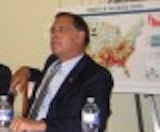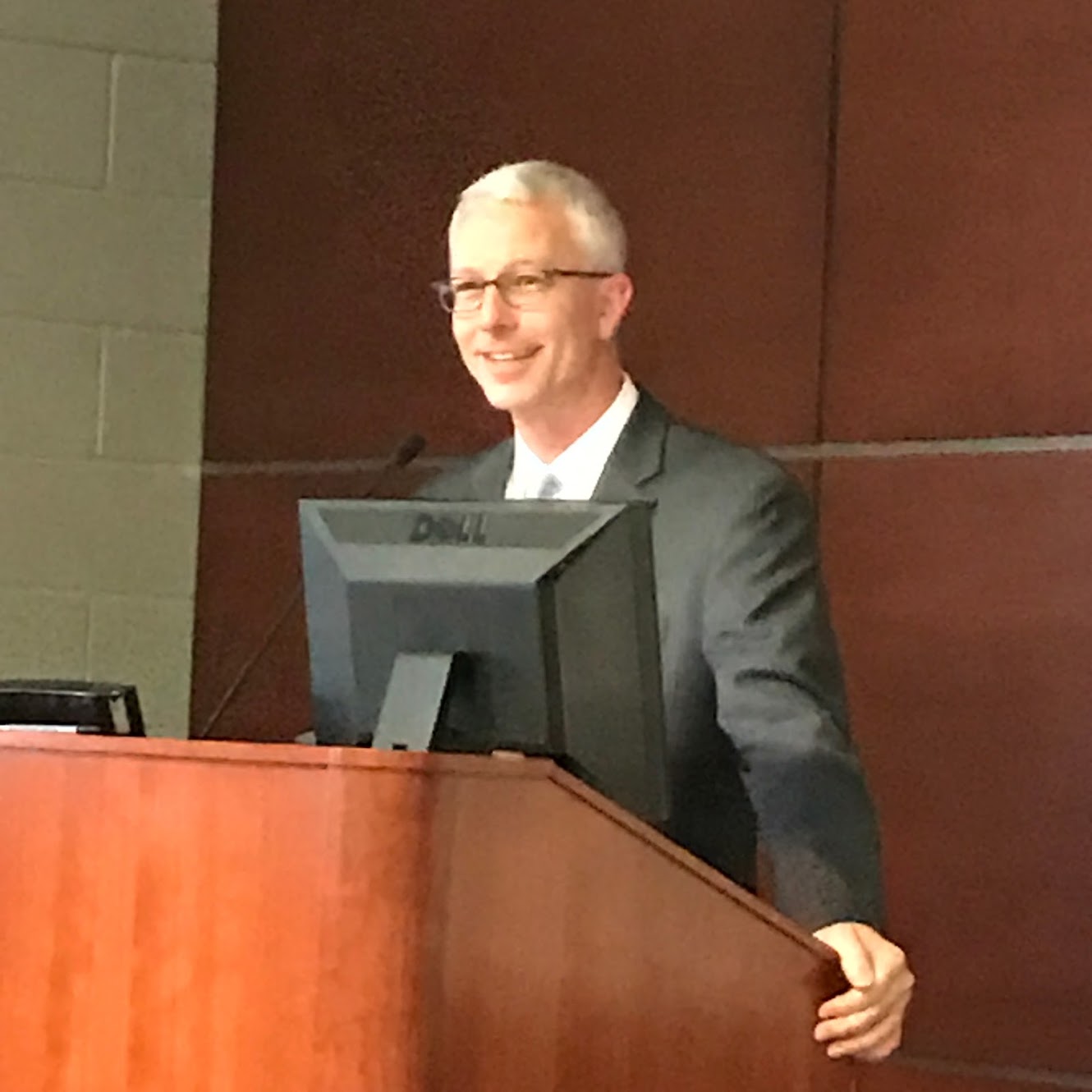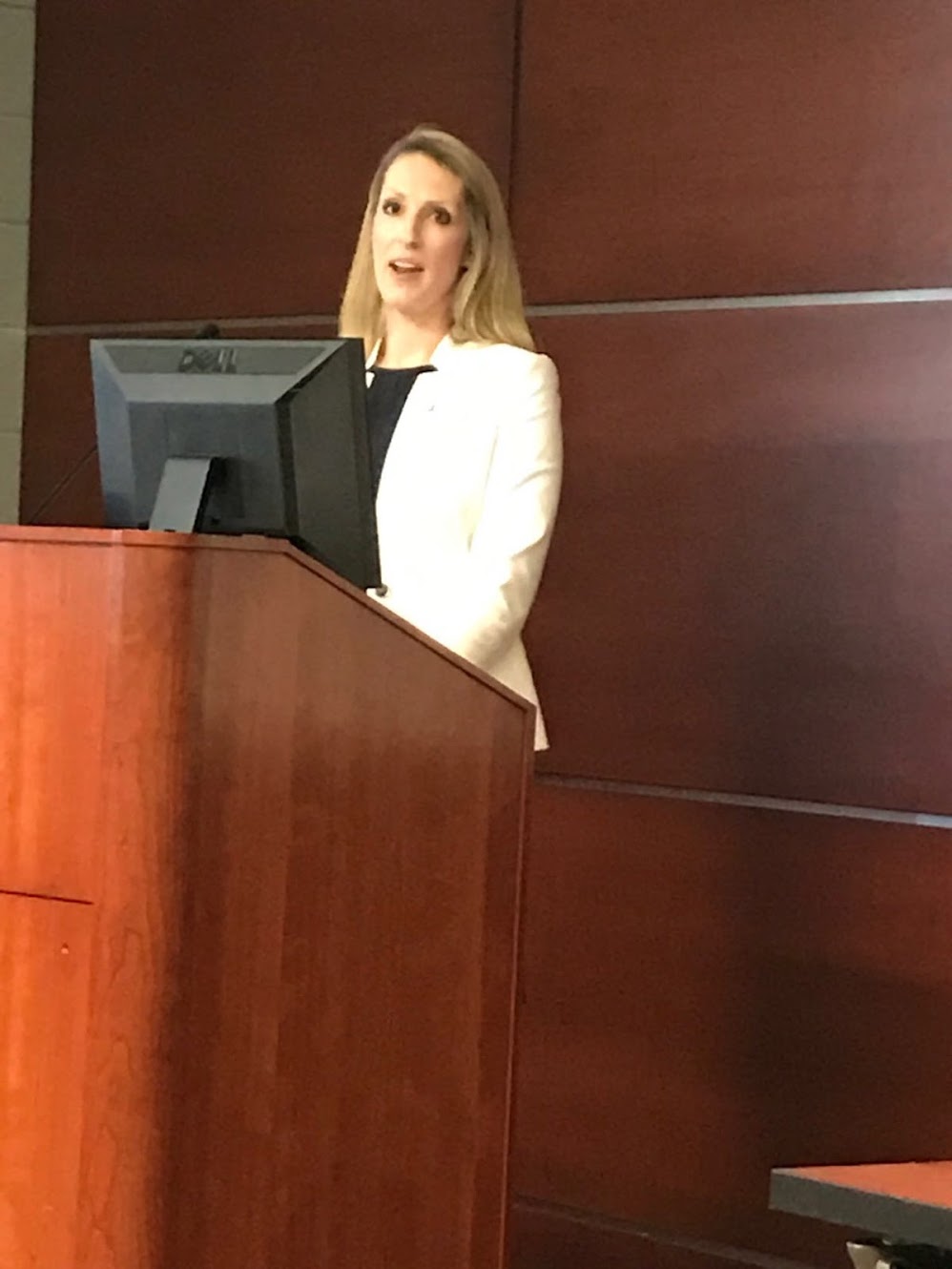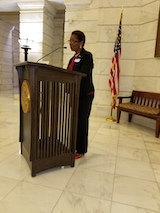Economic Equality Caucus
which advocates for economic equality across the USA.
| Home | Organizational Structure | State Coordinators | Executive Director | Caucus Articles | Memberships | |||||
| "Delta Vision, Delta Voices" | ||||||||||
|
Help Advocate for Economic Progress and Equality. Donate to the Delta Caucus/Economic Equality Caucus. |
||||||||||
Delta Grassroots Caucus Events

Credit Michael Hibblen/ KUAR News, Arkansas Public Radio; Former President Bill Clinton speaking to the Delta Grassroots Caucus on May 2, 2013, at the University of Arkansas Clinton School of Public Service, Little Rock

U. S. Senator John Boozman, Arkansas, at a Delta Grassroots Caucus meeting at the US Capitol

Brad Cole, Executive Director of the Municipal League of Illinois; previously a senior aide to former Republican US Sen. Mark Kirk of Illinois, earlier Mayor of Carbondale, Illinois, veteran Delta regional advocate, speaking at the Delta regional conference in West Memphis, Arkansas on April 26, 2019.

President Bill Clinton makes a comment to Delta Caucus Director Lee Powell at a meeting in Blytheville, Arkansas (in the northeast Arkansas Delta) on Nov. 2, 2014

The Delta Caucus would like to pay tribute to the late, great U.S. Sen. Thad Cochran of Mississippi, a powerful force in the US Senate for decades and a champion for the Delta. Sen. Cochran passed away on May 30, 2019. He spoke to the Delta Caucus on many occasions over the years (he is pictured above speaking to a Caucus event on Capitol Hill in Washington, DC) and his thoughtful, courteous and bipartisan leadership will be sorely missed.

Marcie Lawson, Executive Director, Sikeston, Missouri Regional Chamber and Area Economic Development Corporation, speaking at the Delta regional conference in West Memphis, Arkansas on April 26, 2019.

Alan Gumbel, Greater Memphis Alliance for a Competitive Workforce, Memphis, Tennessee, speaking at the Delta regional conference in West Memphis, Arkansas on April 26, 2019.

Mayor Shirley Washington of Pine Bluff, AR, speaking to the Delta Caucus at the Arkansas Capitol Rotunda in 2017.
Data on Economic, Quality of Life and other Key Indicators for Greater Delta Region--2022
Posted on October 05, 2022 at 04:13 PM
Data on Economic and other Key Indicators for Delta Region, Fall, 2022
Oct. 4, 2022
(NOTE: We may include revisions or additions to this document. This document is more of a reference guide as opposed to an article that can easily be read entirely at one sitting. You may wish to refer back to it occasionally for context. We need to understand that these figures are on the whole negative, with a few bright spots like cost of living.)
EXECUTIVE SUMMARY
Most key indicators remain substantially negative: The Greater Delta Region has six states among the highest 10 poverty levels in the USA, six of the 10 highest food insecurity rankings, and many other economic indicators continue to lag for the region.
Six of the 9 states with the worst child poverty levels are in the Greater Delta.
National rankings for the USA are severely low for child poverty, with 11 million children below the poverty line—about one in 7 kids. The Delta states rank at or near the bottom of the negative national data.
Unfortunately, Louisiana ranked dead last in pollution, Tennessee was 7th and Alabama 9th. For these states, the notion that these areas have rural, wide-open and relatively pollution-free environments is obviously erroneous.
On the positive side, the Delta ranked much higher in indicators regarding cost of living and some areas fared relatively well regarding pollution data:
• five of the 11 states with the lowest cost of living are in the region
• Mississippi and Arkansas ranked above average in air quality.
Unfortunately, Louisiana ranked dead last in pollution, Tennessee was 7th and Alabama 9th.
To get an accurate overview, a range of key indicators have to be considered. Just focusing on a couple of them like poverty or employment will give a skewed picture.
The key indicators for the following are listed below in this document:
1) Poverty
2) Cost of living
3) Unemployment (these figures are always subject to fluctuations and are at best a snap-shot of a particular moment in time)
4) Lowest average incomes
5) Food insecurity
6) Air pollution and 7) Water pollution
8) Quality of life (this is more subjective, with crime levels, education, congestion, and other factors such as poverty often being factored into the various rankings)
TWO IMPORTANT ISSUES REGARDING THE DELTA STATE RANKINGS:
1) National rankings for the USA are disappointingly low among the OECD (Organization for Economic Cooperation and Development) countries that are democracies with market-based economies—the US rates are at 17.8% as compared to 10.7% for 25 OECD countries.
Where does America rank on poverty? The USA is among the three countries with the worst rankings among the 37 OECD countries. Source: OECD Data, 2019.
What the OECD found is that the U.S. rates of poverty are substantially higher and more extreme than those found in the other 25 nations. The overall U.S. rate using this measure stands at 17.8 percent, compared to the 25-country average of 10.7 percent.
The Delta region unfortunately ranks at or near the bottom in poverty rankings within the USA, which ranks substantially below average among other comparable economies.
For average income, the US figures are much more positive than for poverty: the US is 7th in average income at $70,430. Delta states have lower income averages.
2) Delta state rankings are low but with the exception of Mississippi’s consistently high poverty levels, the figures show limited, tentative signs of improvement after the generally higher rates in 2017-2019.
It should not surprise anyone that many of the Delta states still rank near the bottom in poverty, since this historical trend goes back for many decades and the other states the region competes with are not going to stand still. There is some limited evidence of improvement in the Delta poverty levels over the past three years.
It should be emphasized that these minor improvements would have to gather force over a long period of time and become statistically more significant before any conclusion of major improvement can be made. Rates are from Statista.com.
Below are the 10 states with the highest poverty levels, followed by poverty rates for Arkansas, Louisiana, Mississippi, Kentucky and Tennessee.
Rates for Missouri and Illinois are included to some extent further below in this document, but southern Illinois is a very small part of Illinois and urban areas like Chicago are demographically very different from the southernmost part of the state. Southeast Missouri is also a small part of Missouri and that area is substantially different from Kansas City and St. Louis metropolitan areas and the central and northern parts of the state.
STATE RANKINGS IN POVERTY
- Mississippi 19.07%
- Louisiana 18.05%
- New Mexico 17.9%
- West Virginia 16.84%
- Kentucky 15.82%
- Arkansas 15.51%
- Alabama 15.03%
- Oklahoma 14.63%
- South Carolina 13.92%
- Tennessee 13.74%
Missouri ranked 19th with a poverty level of 12.49%
Illinois ranked 26th with a poverty level of 11.62%
Mississippi poverty rates over four years:
2020– 19.6%
2019– 19.6%
2018– 19.7%
2017– 19.8%
Louisiana poverty rates over four years:
2020– 18.6%
2019– 19.0%
2018– 18.6%
2017– 19.7%
Kentucky “”:
2020– 16.6%
2019— 16.3%
2018– 16.9%
2017— 17.2%
Arkansas poverty rates:
2020– 16.1%
2019– 16.2%
2018– 17.2%
2017– 16.4%
Alabama:
2020– 16.0%
2019– 15.5%
2018– 16.8%
2017– 16.9%
States with the greatest percentage of children living in poverty:
6 of the 9 states with the worst child poverty are in the Greater Delta.
- Mississippi – 27.6%
- Louisiana – 26.3%
- New Mexico – 25.6%
- West Virginia – 23.1%
- Alabama – 22.7%
- Kentucky – 22.2%
- Arkansas – 22%
- South Carolina – 21.2%
- Tennessee – 20.8%
Poverty Rate by U.S. State
Fortunately, the U.S. poverty rate trends in recent years are declining; however, poverty is still a significant problem across the country. The national poverty rate in 2017 was 13.4% after falling for the fifth year in a row and was 12.3% in 2019. These numbers are provided by the U.S. Census Bureau, which uses data from the American Community Survey.
The highest poverty rate in the country is in Mississippi, where 19.6% of the population lives in poverty. However, this has improved from 2012, when the state’s poverty rate was nearly 25%.
Mississippi has the lowest median household income of any state of $45,792. Mississippi’s educational attainment levels are among the lowest in the U.S., with about 84.5% of adults graduating high school and 22% of adults having at least a Bachelor’s degree.
DEFINITION OF POVERTY–“How the Census Bureau Measures Poverty.” The amount of income necessary to purchase these basic needs is set by the Office of Management and Budget (OMB). The 2019 poverty line was $13,300 for an individual under age 65 and $12,261 for those 65 or older. The poverty line for a three-person family with one child and two adults was $20,578 in 2019; for a five-person family with two adults and three children the poverty line was $30,510.
I. POVERTY
The poverty rate in 2019 nationally was 12.3%, down from 13.4% in 2017. In the previous five years before 2017 the poverty rate had declined every year. Largely due to COVID-19, poverty levels began increasing during the epidemic and are now beginning to decrease again.
According to the U.S. Census Bureau, the national poverty rate was 11.4% in 2020. This is the first increase in poverty after five annual declines. These states and territories have the highest percentages of poverty in the country: Mississippi, Louisiana, New Mexico, Kentucky, Arkansas, West Virginia, Alabama, the District of Columbia, South Carolina, and Georgia.
These are from the US Census Bureau. Please note that other organizations may have somewhat different rankings, but most of them are generally not too far apart.
Mississippi, Louisiana, Kentucky, Arkansas, Alabama and Tennessee ranked in the bottom 10 states with the worst poverty levels.
STATE RANKINGS IN POVERTY
- Mississippi 19.07%
- Louisiana 18.05%
- New Mexico 17.9%
- West Virginia 16.84%
- Kentucky 15.82%
- Arkansas 15.51%
- Alabama 15.03%
- Oklahoma 14.63%
- South Carolina 13.92%
- Tennessee 13.74%
Missouri ranked 19th with a poverty level of 12.49%
Illinois ranked 26th with a poverty level of 11.62%
(Note: The figures for Missouri and Illinois are much less useful and can be misleading in these analyses, because the Delta areas of these states are a small part of their population as a whole and much of their states include other regions that are generally more affluent and differ substantially from the southernmost Delta states.)
Arkansas, Louisiana and Mississippi include Delta areas that are roughly one half or more of their states. We include the Alabama Black Belt in our region because of its demographic, economic and historical similarities to the Delta as well as its inclusion in the Delta Regional Authority, although it is a small part of Alabama. Alabama as a whole, however, does not differ sharply from Arkansas, Louisiana and Mississippi in most of these indicators.
The western Kentucky Delta is a relatively small part of the overall Delta region, but the eastern part of that state has another economically distressed region–Appalachia–so that Kentucky does not differ sharply on the whole from most of the other Delta states economically and demographically.
Tennessee like Kentucky also includes an Appalachia area in its east that also has lower economic indicators on the whole. Nashville and other urban areas, however, are generally more prosperous and Tennessee generally has a stronger economy on the whole than AR, LA, MS and AL.
II. COST OF LIVING
The Delta has 5 of the 11 states with the lowest cost of living.
Mississippi had the lowest cost of living
Alabama had the fourth lowest
Missouri ranked 7th
Tennessee ranked 10th
Arkansas ranked 11th
Louisiana ranked 18th and Kentucky 24th.
III. UNEMPLOYMENT—July, 2022
(These figures need to be considered along with per capita income where the Delta states generally lag behind, and other factors to give an accurate picture.)
Alabama had the 11th lowest unemployment at 2.6%
Arkansas ranked 25th with 3.3%
Tennessee ranked 27th with 3.3%
Louisiana was 31st at 3.6%
Mississippi was 32nd at 3.6%
Kentucky was 34th at 3.7%
(Missouri was 10th at 2.5%)
IV. States with the Lowest Average Incomes
The ten states with the lowest average incomes are:
- Mississippi - $41,776
- West Virginia - $44,947
- Kentucky - $45,966
- New Mexico - $46,325
- Alabama - $46,957
- Arkansas - $47,274
- South Carolina - $47,458
- Idaho - $48,591
- Oklahoma - $49,078
- Arizona - $49,823
In contrast with the highest paying states, these states have lower educational attainment levels, with particularly lower rates of Bachelor degree holders and graduate or professional degree holders. While average incomes are significantly lower in these states, the livable wages are too because of overall lower costs of living.
V. FOOD INSECURITY
According to data from the Friends Committee on National Legislation and USDA, six of the 10 hungriest states in America are in the Greater Delta Region.
- West Virginia 15.1%
- Mississippi 15.0%
- Louisiana 14.8%
- Oklahoma 14,6%
- Alabama 14.0%
- Kentucky 13.8%
- New Mexico 13.4%
- Texas 13.3%
- Arkansas 12.6%
- Tennessee 12.5%
VI. AIR AND WATER POLLUTION
According to data compiled by US News and World Report, Louisiana has the worst pollution problem of all 50 states. Tennessee and Alabama were in the bottom 10.
• Louisiana ranked dead last. The area between Baton Rouge and New Orleans is often called “cancer alley” due to the high incidences of cancer there.
• Tennessee had the 7th worst pollution.
• Alabama had the 9th worst pollution.
• Mississippi was slightly above average at 28th
• Kentucky was 35th
• Arkansas was 36th
VII. QUALITY OF LIFE
This is the most subjective of the rankings. US News and World Report gave the following explanation of their criteria:
In order to determine rankings, U.S. News & World Report considers a wide range of factors, including healthcare, education, economy, infrastructure, opportunity, fiscal stability, crime and corrections, and natural environment. More information on these categories and what is measured in each can be found below:
• Healthcare includes access, quality and affordability of healthcare, as well as health measurements, such as obesity rates and rates of smoking.
• Education measures how well public schools perform in terms of testing and graduation rates, as well as tuition costs associated with higher education and college debt load.
• Economy looks at GDP growth, migration to the state, and new business.
• Infrastructure includes transportation availability, road quality, communications, and internet access.
• Opportunity includes poverty rates, cost of living, housing costs and gender and racial equality.
• Fiscal Stability considers the health of the government’s finances, including how well the state balances its budget.
• Crime and Corrections ranks a state’s public safety and measures prison systems and their populations.
• Natural Environment looks at the quality of air and water and exposure to pollution.
STATES WITH THE WORST QUALITY OF LIFE
Five heartland Delta states in the bottom 10 regarding US News and World Report Quality of Life rankings:
Louisiana (50th)
Mississippi (49th)
Alabama (46th)
Arkansas (44th)
Kentucky (41st)
Tennessee and Missouri have much smaller Delta areas in their states relative to the state as a whole, and other areas of their state including large urban areas are are substantially different from the heart of the Delta demographically. Tennessee 29th Missouri 28th
USA RANKS LOW IN POVERTY AMONG OECD (Organization for Economic Cooperation and Development) countries
National rankings for the USA are disappointingly low among the OECD (Organization for Economic Cooperation and Development) countries that are democracies with market-based economies—the US rates are at 17.8% as compared to 10.7% for 25 OECD countries.
Where does America rank on poverty? Source: OECD Data, 2019. What the OECD found is that the U.S. rates of poverty are substantially higher and more extreme than those found in the other 25 nations. The overall U.S. rate using this measure stands at 17.8 percent, compared to the 25-country average of 10.7 percent.
The Delta region unfortunately ranks at or near the bottom in poverty rankings within the USA, which ranks substantially below average among other comparable economies.
In the 1960s and 1970s, people in the United States commonly prided themselves on allegedly being the most affluent or one of the most affluent countries in the world, and indeed the economy was stronger then. Some may have found some consolation in the reality that the Delta states may have ranked low, but they were being compared to other states that were well above average in the global rankings; that is no longer true.
Nowadays the USA ranks among the three worst countries in the OECD in poverty levels:
Costa Rica 19.9%
Hungary 17.9%
United States 17.8%
Mexico 16.6%
Greece 12.1%
Not only did countries like Mexico and Greece—that in earlier eras lagged far behind the US—outrank the US in fighting poverty, but 34 of the 37 OECD countries fared better than the US.
Back to the top